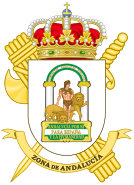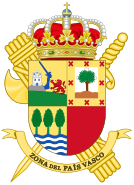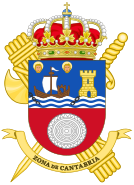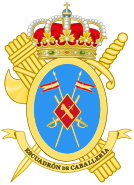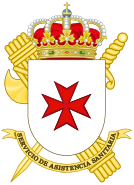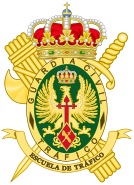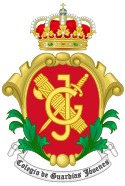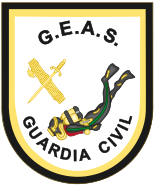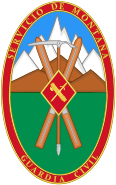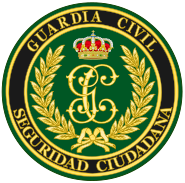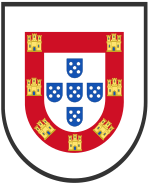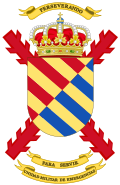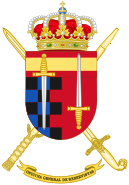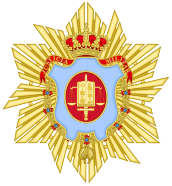Spanish military units have coats of arms, badges and emblems to distinguish them from other units both joint Armed Forces and service branches units.
The first evidence of medieval coats of arms is found in the Bayeux Tapestry from the 11th century, where some of the combatants carry shields painted with crosses. Coats of arms came into general use by feudal lords and knights in battle in the 12th century. By the 13th century arms had spread beyond their initial battlefield use to become a kind of flag or logo for families in the higher social classes of Europe. The use of arms spread to Church clergy, and to towns as civic identifiers, and to royally-chartered organizations such as universities and trading companies. In the 21st century, coats of arms are still in use by a variety of institutions and individuals. Military coats of arms and emblems were first required in navies and air forces to recognize naval fleets and squadrons. Nowadays Spanish military insignia are used for official wear or display by military personnel and Armed Forces units and organizations, including branches, commands, cops, brigades, divisions, regiments, battalions, centres et cetera.
Vicente de Cadenas y Vicent (1915–2005), Chronicler King of Arms of Spain, said military objects and natural figures are the most common heraldic charges used in Spanish Armed Forces heraldry. Chimeric figures are also used but they are uncommon. Mister Cadenas y Vicent also noted there are too many wrongly located charges in Spanish military escutcheons .[1] [2]
<templatestyles src="Template:Gallery/styles.css"></templatestyles>
Coat of Arms of the Joint Forces General Staff of the Armed Forces (EMAD)
Emblem of the Directorate-General of Weaponry and Equipment (DGAM)
Ministry of Defence Emblem of the Directorate-General of Economic Affairs (DIGENECO)
Coat of Arms of General Directorate of Recruitment and Military Education (DIREGEM)
Coat of Arms of the Operations CommandEMAD
Coat of Arms of the Joint Special Operations Command (MCOE)EMAD
Coat of Arms of the Health Operating Command (JESANOP)EMAD
Coat of arms of the Armed Forces Verification Unit (UVE)EMAD
Coat of Arms of the Armed Forces Communications and Information Systems Command (JCISFAS) EMAD
Coat of Arms of the Defence Medical Inspector General's Office (IGSD)
Coat of Arms of the Defence Military Pharmacy Center (CEMILFARDEF)IGSD
Coat of Arms of the Defence Institute of Toxicology (ITOXDEF)IGSD
Coat of Arms of the Defence Institute of Preventive Medicine (IMPDEF)IGSD
Coat of Arms of the Military Blood Transfusion Center (CTFAS)IGSD
Coat of Arms of the Military Veterinary Center (CEMILVET)IGSD
Emblem of the Military Construction Service
Coat of Arms of the Military Horse Breeding Service (SCCFAS) Coat of Arms of the Defence Cataloging Service (SERDEF)
Emblem of the Operations Research Service
Emblem of the Defence Statistical Service
Coat of Arms of the Personnel Council (COPERFAS)
Coat of Arms of the Register Office of Armed Forces Professional Associations (RAPFAS) COPERFAS
Coat of Arms of the Central Defence Academy
Coat of Arms of the Medical School (EMISAN) Central Defence Academy
Emblem of the Military Audit Corps School Central Defence Academy
Coat of Arms of the Military School of Legal Studies (EMEJ) Central Defence Academy
Coat of Arms of the Military School of Music (EMUM) Central Defence Academy
Coat of Arms of the Military School of Education Science (EMCE) Central Defence Academy
Coat of Arms of the Military School of Languages (EMID) Central Defence Academy
Emblem of the National Defence Studies Centre (CESEDEN)
Emblem of the Armed Forces Higher Staff College (ESFAS)
Coat of Arms of the Military Jurisdiction
Coat of Arms of the Canary Islands Joint CommandProposed Unit
Emblem of the Military Medicine
Emblem of the Military Medicine
Emblem of the Military Legal Corps
Emblem of the Military Audit Corps
Emblem of the Military Bands Corps
Emblem of the Joint Special Operations Command (MCOE)
Emblem of the former Higher Defence Studies College (EALEDE)
Emblem of the former Defence High Command (AEM)
Emblem of the former Defence High Command (AEM)
Emblem of the former Board of Joint Chiefs of Staff (JUJEM)
Army [ ] The Army has a fairly high number of coat of arms used by units, centres and organisms, it is the largest and most consistent military coats of arms collection in Spain. Emblems and badges of Army corps, military occupational specialties and some centres are also relevant. After the Uniformity Report adopted in December 1989, coats of arms design and standardization criteria for Spanish Army units and organizations were adopted according to Army Circular 371/70001/87 . The Institute of Military History and Culture (Instituto de Historia y Cultura Militar ), an agency of the Army, provides studies of coats of arms and definitive proposals.[3]
Coats of arms used in the Spanish Army have supporters called attributos (attributes) and displayed diagonally, the most important supporters are:
Units, centres and organisms of Infantry : Two Mauser rifles Spanish model 1893 , armed with bayonets.
Units, centres and organisms of Cavalry : Two Spanish lances model 1861 with flags .
Units, centres and organisms of Artillery : Two 18th-century Spanish cannons.
Units, centres and organisms of Military Engineers : One pick and one shovel.
Units, centres and organisms of Signal Corps : Four Electrodes with rays.
Units, centres and organisms of Logistics Corps : A Mauser rifle Spanish model 1893 armed with bayonet and one torch.
Units, centres and organisms of Army Airmobile Force : Two helicopter rotors.
The Army Headquarters , its divisions, directions, and dependent units directly reporting to it (except the King's Immemorial Infantry Regiment ): Two Spanish captain general 's batons.
Staffs oak branches.The Logistic Support Command and dependent organisms: Two torches.
The Land Force , Canarias Command , Light Forces , Heavy Forces , General Commands , Military Governments and other units, centres and organizations commanded by a general : One Spanish general's baton and sabre.
Units, centres and organizations commanded by a superior officer or an officer : One Spanish officer's baton and sabre.Other relevant heraldic external ornaments are the Spanish Royal Crown and the name of the unit centres and organizations and sometimes the motto is also featured.[4]
<templatestyles src="Template:Gallery/styles.css"></templatestyles>
Emblem of the Military Staff of the Army (EM)
Emblem of the Infantry Forces
Emblem of the Cavalry Forces
Emblem of the Artillery Forces (Common)
Emblem of Artillery Forces (Ornamented)
Emblem of Military Engineers
Emblem of Logistics Forces
Emblem of the Spanish Army Logistics Units (Badge)
Emblem of Specialists Corps
Emblem of the Army Sea Companies
Emblem of Polytechnic Engineers
Emblem and Badge of Military Police
Emblem of Mountain Forces
Emblem of Sergeant Major of the Army
Coat of Arms of the Army Headquarters
Coat of Arms of the Army General StaffCGE
Coat of Arms of the Land Force (FUTER)
Coat of Arms of Canarias Command (MACAN)
Coat of Arms of the Operational Logistics Force (FLO)
Coat of Arms of the High Readiness Land Headquarters (CGTAD)
Coat of Arms of the NATO Rapid Deployable Corps-Spain Headquarters
Coat of Arms of the Economic Affairs Directorate (DIAE)
Coat of Arms of the CIS Command (JCISAT)CGE
Coat of Arms of the Logistic Support Command for Operations FLO
Coat of Arms of the Army Inspector General's Office (IGE)
Coat of Arms of the Army Barracks Directorate (DIACU)
Coat of Arms of the Second Deputy Inspector General's Office "Sur" (SUIGESUR)
Coat of Arms of the Third Deputy Inspector General's Office "Pirenaica" (SUIGEPIR)
Coat of Arms of the Fourth Deputy Inspector General's Office "Noroeste" (SUIGENOR)
Coat of Arms of the Deputy Inspector's Office of the Canarian Forces Command (SUIMCANA)
Coat of Arms of the Infrastructures Directorate (DINF)Inspector General's Office
Coat of Arms of the First Construction Command "Centro"Infrastructures Directorate
Coat of Arms of the Second Construction Command "Sur"Infrastructures Directorate
Coat of Arms of the Third Construction Command "Pirenaica"Infrastructures Directorate
Coat of Arms of the Fourth Construction Command "Noroeste"Infrastructures Directorate
Coat of Arms of the Fifth Construction Command "Canarias"Infrastructures Directorate
Coat of Arms of Ceuta Construction CommandInfrastructures Directorate
Coat of Arms of Melilla Construction CommandInfrastructures Directorate
Coat of Arms of the Infantry Forces Inspector's Office (IINF)
Coat of Arms of the Cavalry Forces Inspector's Office (ICAB)
Coat of Arms of the Artillery Forces Inspector's Office (IART)
Coat of Arms of the Logistics Forces Inspector's Office (ILOG)
Coat of Arms of the Logistic Support Command (MALE)
Coat of Arms of the Acquisitions Directorate (DIAD)MALE
Coat of Arms of the Integration of Logistics Functions Directorate (DINFULOG)MALE
Coat of Arms of the Training and Doctrine Command (MADOC)
Coat of Arms of the Doctrine, Organization and Equipment Directorate (DIDOM)MADOC
Coat of Arms of the Education, Training and Evaluation Directorate (DIENADE)MADOC
Coat of Arms of the Training Command "Centro"DIENADE
Coat of Arms of the Training Command "Norte"DIENADE
Coat of Arms of the Training Command "Sur"DIENADE
Coat of Arms of the Training Command "Este"DIENADE
Coat of Arms of the Training Command of the Canary IslandsDIENADE
Coat of Arms of the Personnel Command (MAPER)
Coat of Arms of the Personnel Directorate (DIPER)MAPER
Coat of Arms of the Personnel Support Directorate (DIAPER)MAPER
Coat of Arms of the Health Directorate (DISAN)MAPER
Coat of Arms of División San Marcial
Coat of Arms of the Division Castillejos
Coat of Arms of Balearics General Command (COMANGEBAL)
Coat of Arms of Ceuta General Command (COMENGECEU)
Coat of Arms of Melilla General Command (COMANGEMEL)
Coat of Arms of the Army Field Artillery Command (MACA)
Coat of Arms of the Army Airmobile Force (FAMET)
Coat of Arms of the Engineer Command (MING)
Coat of Arms of the Signals Command (MATRANS)
Coat of Arms of the Logistic Brigade (BRILOG)
Coat of Arms of the Medical Brigade (BRISAN)
Coat of Arms of 1st "Aragón" (BOP I)
Coat of Arms of 7th Brigade "Galicia"
Coat of Arms of 10th Brigade "Guzmán el Bueno" (BOP X)
Coat of Arms of 11th Brigade "Extremadura"
Coat of Arms of 12th "Guadarrama"
Coat of Arms of 16th Brigade "Canarias"
Coat of Arms of the 1st Intelligence Regiment (RINT-1)
Coat of Arms of the 1st Information Operations Regiment (ROI-1)
Coat of Arms of the 1st CBRN-Defense Regiment "Valencia" (RDNBQ)
Coat of Arms of the 1st Engineer Regiment
Coat of Arms of the 1st Signal Regiment (RT-1)
Coat of Arms of the 2nd Infantry Regiment "La Reina" (RI-2)
Coat of Arms of the 3rd Infantry Regiment "Príncipe" (RI-3)
Coat of Arms of the 3rd Cavalry Regiment "Montesa" (RC-3)
Coat of Arms of the 4th Armoured Regiment "Pavía" (RAC-4)
Coat of Arms of the 4th Coastal Artillery Regiment (RACTA-4)
Coat of Arms of the 6th Infantry Regiment "Saboya"
Coat of Arms of the 6th Infantry Regiment "Saboya"
Coat of Arms of the 7th Engineer Regiment (RING-7)
Coat of Arms of the 8th Engineer Regiment (RING-8)
Coat of Arms of the 9th Infantry Regiment "Soria" (RI-9)
Coat of Arms of the 10th Armored Cavalry Regiment "Alcántara" (RCAC-10)
Coat of Arms of the 10th Armored Regiment "Córdoba"
Coat of Arms of the 10th Armored Regiment "Córdoba"
Coat of Arms of the 11th Cavalry Regiment "España" (RC-11)
Coat of Arms of the 11th Field Artillery Regiment (RACA-11)
Coat of Arms of the 11th Engineers' Specialities (REI-11)
Coat of Arms of the 12th Cavalry Regiment "Farnesio" (RC-12)
Traditional and common emblem of the 12th Cavalry Regiment "Farnesio"
Coat of Arms of the 12th Bridge Engineer Regiment (RPEI-12)
Coat of Arms of the 16th Armored Regiment "Castilla"
Coat of arms of the 16th Armored Regiment "Castilla"
Coat of Arms of the 20th Field Artillery Regiment (RACA-20)
Coat of Arms of the 21st Signal Regiment (RT-21)
Coat of Arms of the 22nd Signal Regiment (RT-22)
Coat of Arms of the 29th Infantry Regiment "Isabel la Católica"
Coat of Arms of the 29th Infantry Regiment "Isabel la Católica"
Coat of Arms of the 30th Mixed Artillery Regiment (RAMIX-30)
Coat of Arms of the 31st Mechanized Infantry Regiment "Asturias" (RIMZ-31)
Coat of Arms of the 31st Electronic Warfare Regiment (REW-31)
Coat of Arms of the 32nd Mixed Artillery Regiment (RAMIX-32)
Coat of Arms of the 32nd Electronic Warfare Regiment (REW-32)
Coat of Arms of the 45th Infantry Regiment "Garellano", (RI-45)
Coat of Arms of the 49th Infantry Regiment "Tenerife"
Coat of Arms of the 50th Infantry Regiment "Canarias"
Coat of Arms of the 50th Infantry Regiment "Canarias"
Coat of Arms of the 61st Armoured Infantry Regiment "Alcázar de Toledo" (RIAC-61)
Coat of Arms of the 62nd Infantry Regiment "Arapiles" (RI-62)
Coat of Arms of the 63rd Infantry Regiment "Barcelona" (RI-63)
Coat of Arms of the 63rd Rocket Artillery Regiment (RALCA-63)
Coat of Arms of the 64th Mountain Hunters Regiment "Galicia" (RCZM-64)
Coat of Arms of the 66th Infantry Regiment "América" (RI-66)
Coat of Arms of the 67th Infantry Regiment "Tercio Viejo de Sicilia" (RI-67)
Coat of Arms of the 71st Air Defence Artillery Regiment (RAAA-71)
Coat of Arms of the 73rd Air Defence Artillery Regiment (RAAA-73)
Coat of Arms of the 74th Air Defence Artillery Regiment (RAAA-74)
Coat of Arms of the 93rd Field Artillery Regiment (RACA-93)
Coat of Arms of the 94th Air Defence Artillery Regiment (RAAA-94)
Coat of Arms of the Parachute Brigade Headquarters
Coat of arms of the 4th Parachute Infantry Regiment "Napoles" (RIPAC-4)
Coat of arms of the 5th Infantry Regiment "Zaragoza" (RI-5)
Coat of Arms of the 8th Cavalry Regiment Lusitania (RC-8)
Coat of arms of the 1st-4 Parachute Infantry Flag "Roger de Flor" (BIPAC-I/4)
Coat of Arms of the 2nd-4 Protected Infantry Flag "Roger de Lauria" (BIP-II/4)
Coat of Arms of the 3rd-5 Protected Infantry Flag "Ortiz de Zárate" (BIP-III/5)
Coat of Arms of the 6th Field Parachute Artillery Battalion (GACAPAC-VI)
Coat of Arms of the 6th Engineer Battalion (BZAP-VI)
Coat of Arms of the 6th Logistic Battalion (GL-VI)
Coat of Arms of the 6th Parachute Signal Company (CIATRANSPAC-6)
Coat of Arms of the Parachute Brigade Headquarters Battalion (BON CG BRIPAC)
Coat of Arms of the Air Drop Unit (ULANPAC)
Coat of Arms of the Parachute Anti-Tank Defense Company (CIADCCPAC)
Coat of Arms of the Parachute Brigade Intelligence Company (CIAINTPAC)
Coat of Arms of the 1st-8 Light Armored Cavalry Group "Sagunto" (GCLAC-I/8)
Coat of Arms of the Base Services Unit "Príncipe" (USBA)
Coat of Arms of the Barracks Services Unit "Primo de Rivera" (USAC)
Coat of Arms of the Barracks Services Unit "Santa Bárbara" (USAC)
Coat of Arms of the Parachute Instruction Unit (UFPAC)
Emblem of the 1st Spanish Legion Tercio "Great Captain"
Emblem of the 2nd Spanish Legion Tercio "Duke of Alba"
Emblem of the 3rd Spanish Legion Tercio "Don Juan de Austria"
Emblem of 4th Spanish Legion Tercio "Alexander Farnese"
Coat of Arms of the 52nd Regulares Light Infantry Group/Regiment
Coat of Arms of the 54th Regulares Light Infantry Group/Regiment
Coat of Arms of the 1st-52 Regulares Battalion "Alhucemas"
Coat of Arms of the 1st-54 Regulares Battalion "Tetuán"
Coat of Arms of the High Readiness Land Headquarters Battalion (BON CG CGTAD)
Coat of Arms of the Infantry Battalion "Guardia Vieja de Castilla" (BI)
Coat of Arms of the 1st-1 NBC-Defense Battalion (BNBQ I/1)
Coat of Arms of the 1st-1Combat Engineer Battalion
Coat of Arms of the 1st-2 Protected Infantry Battalion "Princesa" (BIP-I/2)
Coat of Arms of the 1st-3 Protected Infantry Battalion "San Quintín" (BIP-I/3)
Coat of Arms of the 1st-4 Tank Infantry Battalion "Flandes" (BICC-I/4)
Coat of Arms of the 1st-3 Armored Cavalry Group "Cazadores de África" (GCAC-I/3)
Coat of Arms of the 1st-4 Coastal Artillery Battalion (GACTA-I/4)
Coat of Arms of the 1st-6 Mechanized Infantry Battalion "Cantabria" (BIMZ-I/6)
Coat of Arms of the 1st-7 Combat Engineer Battalion I/7
Coat of Arms of the 1st-8 Combat Engineer Battalion
Coat of Arms of the 1st-9 Protected Infantry Battalion "Fuerteventura" (BIPROT-I/9)
Coat of Arms of the 1st-10 Armored Cavalry Group "Taxdirt" (GCAC-I/10)
Coat of Arms of the 1st-10 Tank Infantry Battalion "Málaga"
Coat of Arms of the 1st-11 Light Armored Cavalry Group "Lanceros de Borbón" (GCLAC-I/11)
Coat of Arms of the 1st-11 Field Artillery Battalion (GACA-I/11)
Coat of Arms of the 2nd-11 Field Artillery Battalion (GACA-II/11)
Coat of Arms of the 1st-11 Road Building Battalion
Coat of Arms of the 2nd 11 Camp Building Battalion
Coat of arms of the 1st-12 Light Armored Cavalry Group "Santiago"
Coat of Arms of the 1st-12 Bridge Building Battalion
Coat of Arms of the 2nd-12 Railroad Building Battalion
Coat of Arms of the 1st-16 Tank Infantry Battalion "Mérida"
Coat of Arms of the 1st-20 Field Artillery Battalion (GACA-I/20)
Coat of Arms of the 1st-29 Protected Infantry Battalion "Zamora" (BIP-I/29)
Coat of Arms of the 1st-30 Field Artillery Battalion (GACA-I/30)
Coat of Arms of the 1st-31 Mechanized Infantry Battalion "Covadonga" (BIMZ-I/31)
Coat of Arms of the 1st-32 Field Artillery Battalion (GACA-I/32)
Coat of Arms of the 1st-45 Motorized Infantry Battalion "Guipúzcoa" (BIMT-I/45)
Coat of Arms of the 1st-47 Motorized Infantry Battalion "Filipinas" (BIMT-I/45)
Coat of Arms of the 1st-49 Motorized Infantry Battalion "Albuera"
Coat of Arms of the 1st-50 Protected Infantry Battalion "Ceriñola"
Coat of Arms of the 1st-61 Tank Infantry Battalion "León"
Coat of Arms of the 1st-62 Mechanized Infantry Battalion "Badajoz" (BIMZ-I/62)
Coat of Arms of the 1st-63 Motorized Infantry Battalion "Cataluña"
Coat of Arms of the 1st-63 Rocket Artillery Group (GALCA-I/63)
Coat of Arms of the 1st-64 Mountain Hunters Battalion "Pirineos" (BCZM-I/64)
Coat of Arms of the 1st-64 Skiing-Climbing Company
Coat of Arms of the 1st-66 Motorized Infantry Battalion "Montejurra" (BIMT-I/66)
Coat of Arms of the 1st-67 Motorized Infantry Battalion "Legazpi" (BIMT-I/67)
Coat of Arms of the 1st-71 Air Defence Artillery Battalion (GAAA-I/71)
Coat of Arms of the 1st-73 Aspide Air Defence Artillery Battalion
Coat of Arms of the 1st-74 Air Defence Artillery Battalion
Coat of Arms of the 1st-93 Field Artillery Battalion (GACA-I/93)
Coat of Arms of the 1st-94 Air Defence Artillery Battalion (GAAA-I/94)
Coat of Arms of the 1st Engineer Battalion
Coat of Arms of the 1st Signals Company
Coat of Arms of the 2nd-2 Mechanized Infantry Battalion "Lepanto" (BIMZ-II/2)
Coat of Arms of the 2nd-3 Protected Infantry Battalion "Toledo" (BIP-II/3)
Coat of Arms of the 2nd-4 Cavalry Armored Group "Húsares de la Princesa"
Coat of Arms of the 2nd-6 Protected Infantry Battalion "Las Navas" (BIP-II/6)
Coat of Arms of the 2nd-32nd Air Defence Artillery Battalion (GAAA-II/32)
Coat of Arms of the 2nd-10 Armored Cavalry Group "Almansa"
Coat of Arms of the 2nd-11 Light Armored Cavalry Group "Numancia"
Coat of Arms of the 2nd-16 Armored Cavalry Group "Calatrava"
Coat of Arms of the 2nd–30th Air Defence Artillery Battalion (GAAA-II/30)
Coat of Arms of the 2nd-31 Protected Infantry Battalion "Uad Ras" (BIP-II/31)
Coat of Arms of the 2nd-71 Air Defence Artillery Battalion (GAAA-II/71)
Coat of Arms of the 2nd-73 NASAMS Air Defence Artillery Battalion
Coat of Arms of the 2nd-74 Air Defence Artillery Battalion (GAAAM-II/74)
Coat of Arms of the Coat of Arms of the 2nd-63 Information and Location Artillery Battalion
Coat of Arms of the 3rd-73 Patriot Air Defence Artillery Battalion
Coat of Arms of the 3rd-74 Repair Unit (UR-III/74)
Coat of Arms of the 7th Field Artillery Battalion
Coat of Arms of the 7th Engineer Battalion
Coat of Arms of the 7th Signals Company
Coat of Arms of the 10th Field Artillery Battalion
Coat of Arms of the 10th Engineer Battalion
Coat of Arms of the 10th Signals Company
Coat of Arms of the 11th Field Artillery Battalion
Coat of Arms of the 11th Engineer Battalion
Coat of Arms of the 11th Signals Company
Coat of Arms of the 12th Armored Cavalry Group "Villaviciosa"
Coat of arms of the 12th Self Propelled Field Artillery Battalion
Coat of Arms of the 12th Engineer Battalion
Coat of Arms of the 12th Signals Company
Coat of Arms of the 16th Light Armored Cavalry Group "Milán" XVI (GCLAC-XVI)
Coat of Arms of the 16th Engineer Battalion
Coat of Arms of the 16th Signals Company
Coat of Arms of the 17th Signals Company
Coat of Arms of the 18th Signals Company
Coat of Arms of the Division "Castillejos" Headquarters
Coat of Arms of the Division "Castillejos" Headquarters Battalion
Coat of Arms of the Division "San Marcial" Headquarters
Coat of Arms of the Division "San Marcial" Headquarters Battalion
Coat of Arms of the Signal Battalion of the Air Defence Command (UTMAAA)
Coat of Arms of the 1st Brigade "Aragón" Headquarters Battalion
Coat of Arms of the 7th Brigade "Galicia" Headquarters Battalion
Coat of Arms of the 10th Brigade "Guzmán el Bueno" Headquarters Battalion
Coat of Arms of the 11th Brigade "Extremadura" Headquarters Battalion
Coat of Arms of the 12th Brigade "Guadarrama" Headquarters Battalion
Coat of Arms of the 16th Brigade "Canarias" Headquarters Battalion
Coat of Arms of the Ceuta General Command Headquarters Battalion
Coat of Arms of the Melilla General Command Headquarters Battalion
Coat of Arms of the Music Unit of the
RI-1 Coat of Arms of the Support Unit of the RI-1
Coat of Arms of the Personnel Command of the Canary Islands (JEPERCANA)
Coat of Arms of the Personnel Command of Ceuta (JEPERCE)
Coat of Arms of the Personnel Command of Melilla (JEPERMEL)
Coat of Arms of the 1st-1 Intelligence Analysis GroupRINT-1
Coat of Arms of the 2nd-1 Long Range Reconnaissance GroupRINT-1
Coat of Arms of the 4th-1 Unmanned Aerial Vehicles GroupRINT-1
Coat of Arms of the 1st Civil-Military Cooperation Battalion (BCIMIC-I/1)ROI-1
Coat of Arms of the 2nd-1 Information Operations GroupROI-1
Coat of Arms of the 1st Military Police Battalion (BON PM-I)
Coat of Arms of the Army Helicopters Training Center (CEFAMET)
Coat of Arms of the Transport Grouping (ATP)
Coat of Arms of the 11th Logistics Support Grouping
Coat of Arms of the 21st Logistics Support Grouping (AALOG-21)
Coat of Arms of the 41st Logistics Support Grouping (AALOG-41)
Coat of Arms of the 61st Logistics Support Grouping (AALOG-61)
Coat of Arms of the 81st Logistics Support Grouping (AALOG-81)
Coat of Arms of the 1st Logistics Group
Coat of Arms of the 7th Logistics Air-transportable Group (GLAT-VII)
Coat of Arms of the 10th Logistics Group
Coat of Arms of the 11th Logistics Group
Coat of Arms of the 12th Logistics Group
Coat of Arms of the 16th Logistics Group
Coat of Arms of the 23rd Logistics Unit (ULOG-23)
Coat of Arms of the 24th Logistics Unit (ULOG-24)
Coat of Arms of the 1st-11 Supply Group
Coat of Arms of the 3rd-11 Projection Support Group
Coat of Arms of the 6th-11 Maintenance Group
Coat of Arms of the 112th Services and Mechanical Workshops Unit
Coat of Arms of the 1st-21 Supply Group
Coat of Arms of the 6th-21 Maintenance Group
Coat of Arms of the 9th-21 Transport Group
Coat of Arms of the 212th Services and Mechanical Workshops Unit
Coat of Arms of the 1st-41 Supply Group
Coat of Arms of the 6th-41 Maintenance Group
Coat of Arms of the 9th-41 Transport Group
Coat of Arms of the 412th Services and Mechanical Workshops Unit
Coat of Arms of the 1st-61 Supply Group
Coat of Arms of the 3rd-61 Logistics Group (GLOG-III/61)
Coat of Arms of the 612th Services and Mechanical Workshops Unit
Coat of Arms of the 6th-81 Maintenance Group
Coat of Arms of the 811th Munitions Battery
Coat of Arms of the 812th Services and Mechanical Workshops Unit
Coat of Arms of the Automobile Unit of the
RI-1 Coat of Arms of the Ceuta Sea Company
Coat of Arms of the Melilla Sea Company
Coat of Arms of the Projection Support Unit "Marques de Herrera" (UAPRO)
Coat of Arms of the Projection Support Unit "El Fuerte" (UAPRO)
Coat of Arms of the Projection Support Unit "Anatolio Fuentes" (UAPRO)
Coat of Arms of the Projection Support Unit "Christopher Columbus" (UAPRO)
Coat of Arms of the Projection Support Unit "San Isidro" (UAPRO)
Coat of Arms of the Logistics Centers CommandDINFULOG
Coat of Arms of the Logistics Material Supplying Park and Center (PCAMI)
Coat of Arms of the Signal Equipment Maintenance Park and Center (PCMMT)
Coat of Arms of the Military Engineers Equipment Maintenance Park and Center (PCMMI)
Coat of Arms of the 1st Wheeled Vehicles Maintenance Park and Center (PCMVR-1)
Coat of Arms of the 2nd Wheeled Vehicles Maintenance Park and Center (PCMVR-2)
Coat of Arms of the 1st Armored Systems Maintenance Park and Center (PCMASA-1)
Coat of Arms of the 2nd Armored Systems Maintenance Park and Center (PCMASA-2)
Coat of Arms of the Artillery Weaponry and Equipment Maintenance Park and Center (PCMAYMA)
Coat of Arms of the Air Defence, Coastal and Missile Systems Maintenance Park and Center (PCMASACOM)
Coat of Arms of the Hardware and Software Systems Maintenance Park and Center (PCMSHS)
Coat of Arms of the Army's Central Laboratory (LCE)
Coat of Arms of the Discontinuous Services Unit "Cavalcanti"
Coat of Arms of the Discontinuous Services Unit "Ceuta"
Coat of Arms of the Discontinuous Services Unit "Melilla"
Coat of Arms of the Discontinuous Services Unit "Teniente Flomesta"
Coat of Arms of the Discontinuous Services Unit "Oroel"
Coat of Arms of the Discontinuous Services Unit "San Jorge"
Coat of Arms of the Discontinuous Services Unit "La Cuesta"
Coat of Arms of the Base Services Unit
Coat of Arms of the Base Services Unit
Coat of Arms of the Base Services Unit
Coat of Arms of the Base Services Unit
Coat of Arms of the Base Services Unit "Jaime I"
Coat of Arms of the Base Services Unit
Coat of Arms of the Base Services Unit "Araca"
Coat of Arms of the Base Services Unit
Coat of Arms of the Base Services Unit
Coat of Arms of the Base Services Unit
Coat of Arms of the Base Services Unit
Coat of Arms of the Base Services Unit "General Alemán Ramírez"
Coat of Arms of the Barracks Services Unit "General Álvarez de Castro"
Coat of Arms of the Barracks Services Unit "Cabo Noval"
Coat of Arms of the Barracks Services Unit "Loyola"
Coat of Arms of the Barracks Services Unit "Aizoáin"
Coat of Arms of the 1st Health Services Group (AGRUSAN-1)
Coat of Arms of the 3rd Health Services Group (AGRUSAN-3)
Coat of Arms of the Health Logistics Support Unit (UALSAN)
Coat of Arms of the 1st-1 Health Services GroupAGRUSAN-1
Coat of Arms of the 2nd-1 Health Services GroupAGRUSAN-1
Coat of Arms of the 3rd-3 Health Services GroupAGRUSAN-3
Coat of Arms of the 4th-3 Health Services GroupAGRUSAN-3
Coat of Arms of the NBC Decontamination Sanitary Station (EDSBNQ)AGRUSAN-3
Coat of Arms of the General Military Academy (AGM)
Coat of Arms of the Infantry Academy (ACINF)
Coat of Arms of the Infantry Academy (ACINF)
Coat of Arms of the Cavalry Academy (ACAB)
Coat of Arms of the Artillery Academy (ACART)
Coat of Arms of the Artillery Academy (ACART)
Coat of Arms of the Engineering Military Academy (ACING)
Coat of arms of the Logistics Academy (ACLOG)
Coat of Arms of the Basic General Academy of Non-Commissioned Officers (AGBS)
Coat of Arms of the Mountain and Special Operations Military School (EMMOE)
Coat of Arms of the Polytechnic School of the Army (ESPOL)
Coat of Arms of the Nuclear, Biological and Chemical Defence Military School (EMDNBQ)
Coat of Arms of the Central School of Physical Education (ECEF)Infantry Academy
Coat of Arms of the 1st Troop Training Centre (CFOT-1)
Coat of Arms of the 2nd Troop Training Centre (CFOT-2)
Coat of Arms of the National Training Center "Chinchilla"
Coat of Arms of the National Training Center "San Gregorio"
Coat of Arms of the Army War College (ESGET)
Coat of Arms of the Military Inter-Arms School (EINT)Army War College
Coat of Arms of the Geography Centre of the Spanish Army (CEGET)
Coat of Arms of the Army Orphan Patronage
Coat of Arms of the Military Culture and History Center "Canarias" (CHCMCAN)
Coat of Arms of the Military Culture and History Center "Centro" (CHCMCEN)
Coat of Arms of the Military Culture and History Center "Sur" (CHCMSUR)
Coat of Arms of the Military Culture and History Center "Noroeste" (CHCMNOR)
Coat of Arms of the Military Culture and History Center "Pirenaico" (CHCMPIR)
Coat of Arms of the Military Culture and History Center "Baleares" (CHCMBAL)
Coat of Arms of the Military Culture and History Center "Ceuta" (CHCMCEU)
Coat of Arms of the Military Culture and History Center "Melilla" (CHCMMEL)
Emblem of the IHCM Fortress Defense Course
Emblem of the IHCM Introduction to Military History Course
Emblem of the IHCM General and Military Heraldry Course
Emblem of the IHCM Military Heritage Course
Emblem of the IHCM History and Aesthetics of Military Music Course
Emblem of the IHCM Uniformology Course
Emblem of the IHCM Military Vexillology Course
Emblem of the IHCM Weaponry Course
Coat of Arms of General Military Archives of Madrid (AGMIMAD)
Coat of Arms of General Military Archives of Ávila (AGMAV)
Coat of Arms of General Military Archives of Segovia (AGMSE)
Coat of Arms of General Military Archives of Guadalajara (AGMGU)
Coat of Arms of the Central Military Library (BCM)
Emblem of the Army Museum
Former Emblem of the Army(1943–1975)
Coat of Arms of the former 1st Military Region
Coat of Arms of the former 2nd Military Region
Coat of Arms of the former 3rd Military Region
Coat of Arms of the former 4th Military Region
Coat of Arms of the former 5th Military Region
Coat of Arms of the former 6th Military Region
Coat of Arms of the former 7th Military Region
Coat of Arms of the former 8th Military Region
Coat of Arms of the former 9th Military Region
Coat of Arms of the former General Captaincy of the Balearic Islands
Coat of Arms of the former General Captaincy of the Canary Islands
Coat of Arms of Ceuta General Command
Coat of Arms of Melilla General Command
Coat of Arms of the former 1st Military Region, "Centro"
Coat of Arms of the former 2nd Military Region, "Sur"
Coat of Arms of the former 3rd Military Region, "Levante"
Coat of Arms of the former 4th Military Region, "Pirenaica Oriental"
Coat of Arms of the former 5th Military Region, "Pirenaica Occidental"
Coat of Arms of the former 6th Military Region, "Noroeste"
Coat of Arms of the former 1st Military Region, "Centro"
Coat of Arms of the former 2nd Military Region, "Sur"
Coat of Arms of the former 3rd Military Region, "Pirenaica"
Coat of Arms of the former 4th Military Region, "Noroeste"
Coat of Arms of the former Military Zone of the Balearic Islands
Coat of Arms of the former Military Zone of the Canary Islands
Coat of Arms of the Former Inspector General of Mobilization's Office (IGM)
Coat of Arms of the Former Transport Directorate (DITRA)
Former Coat of Arms of the Signals Command (MATRANS)
Coat of Arms of the former 1st Armoured Division "Brunete"
Coat of arms of the former 2nd Mechanized Division "Guzmán el Bueno"
Coat of arms of the former 3rd Motorized Infantry Division "Maestrazgo"
Coat of arms of the former 4th Mountain Division "Urgel"
Coat of arms of the former 6th Mountain Division "Navarra"
Coat of Arms of the former Heavy Forces (FPES)
Coat of Arms of former Light Forces (FUL)
Coat of Arms of the former Coastal Artillery of the Strait Command (MACTAE)
Coat of Arms of the former Coastal Artillery Command (MACTA)
Coat of Arms of the former 1st Brigade of Mountain Hunters "Aragón"
Coat of Arms of the former Mountain Troops Command "Aragón" (JTM)
Coat of Arms of the former 1st Cavalry Brigade "Jarama" (BRICAB-I)
Coat of Arms of the former 2nd Cavalry Brigade "Castillejos" (BRICAB)
Former Coat of Arms of the 2nd Legion Brigade "King Alfonso XIII"Second Version
Coat of Arms of the former 3rd Light Infantry Brigade "Maestrazgo" (BRIL-III)
Coat of Arms of the former 4th Light Infantry Brigade "Urgel" (BRIL-IV)
Coat of Arms of the former 5th Light Infantry Brigade "San Marcial" (BRIL-V)
Coat of Arms of the former 7th Light Infantry Brigade "Galicia" (BRILAG)
Coat of Arms of the former 10th Mechanized Infantry Brigade "Guzmán el Bueno" (BRIMZ-X)
Coat of Arms of the former 11th Mechanised Infantry Brigade "Extremadura" (BRIMZ-XI)
Coat of Arms of the former 12th Armored Infantry Brigade "Guadarrama" (BRIAC-XII)
Coat of Arms of the former 16th Light Infantry Brigade "Canarias" (BRILCAN-XVI)
Coat of Arms of the former 1st Land Logistics Force
Coat of Arms of the former 2nd Land Logistics Force
Coat of Arms of the former 1st Light Armored Cavalry Regiment "Santiago" (RCLAC-1)
Coat of Arms of the former 2nd Signal Regiment
Coat of Arms of the former 4th Light Armoured Cavalry Regiment "Pavía" (RACAC-4)
Traditional Emblem of the former Cavalry Regiment "Almansa"
Coat of Arms of the former 5th Light Armoured Cavalry Regiment "Almansa" (RCLAC-5)
Traditional Emblem of the former Cavalry Regiment "Numancia"
Coat of Arms of the former 9th Light Armoured Cavalry Regiment "Numancia" (RCLAC-9)
Coat of Arms of the former 10th Mechanized Infantry Regiment "Córdoba"
Coat of Arms of the former 13th Railway Regiment
Traditional Emblem of the former Cavalry Regiment "Villaviciosa"
Coat of Arms of the former 14th Light Armoured Cavalry Regiment "Villaviciosa" (RCLAC-14)
Coat of Arms of the former 14th Field Artillery Regiment (RACA-14)
Coat of Arms of the former 16th Mechanized Infantry Regiment "Castilla"(RIMZ-16)
Coat of Arms of the former 22nd Hunter Cavalry Regiment "Victoria Eugenia"
Coat of Arms of the former 32nd Infantry Regiment San Quintín (RINF-32)
Coat of Arms of the former 37th Infantry Regiment Órdenes Militares
Coat of Arms of the former 51st Logistics Support Grouping
Coat of Arms of the former 62nd Rocket Artillery Regiment (RALCA-62)
Coat of Arms of the former 72nd Air Defence Artillery Regiment
Coat of Arms of the former 81st Air Defence Artillery Regiment (RAAA-81)
Coat of Arms of the former 91st Mixed Artillery Regiment (RAMIX-91)
Coat of Arms of the former 2nd Health Services Group (AGRUSAN-2)
Coat of Arms of the former Field Hospital Group (AGRUHOC)
Coat of Arms of the former 1st Mountain Artillery Battalion
Coat of Arms of the former 1st Mountain Engineer Unit (UZM-I)
Coat of Arms of the former 1st-4 Armored Cavalry Group "Cazadores de María Cristina" (GCAC-I/4)
Coat of Arms of the former 1st-62 Rocket Artillery Group
Coat of Arms of the former 1st-81 SAM Patriot Missile Artillery Battalion (GAAA-I/81)
Coat of Arms of the former 2nd-11 Mechanized Cavalry Group "Húsares Españoles"
Coat of Arms of the former 2nd-52 Regulares Battalion "Rif" (TR-II/52)
Coat of Arms of the former 3rd-66 Mountain Hunters Battalion "Estella"
Coat of Arms of the former 5th Field Artillery Battalion
Coat of Arms of the former 5th Engineer Unit
Coat of Arms of the former 5th Signals Company
Coat of Arms of the former 1st Divisional Logistics Group
Coat of Arms of the former Divisional Logistics Group (GLOGDIV) AALOG-61
Coat of Arms of the former Audit Corps Academy
Coat of Arms of the Military Stud (YM)
Navy [ ] The Spanish Navy uses more emblems than coats of arms used by units, flotillas Navy Marines , Naval Action Forces, Maritime Action Forces, centres, organisms and Fleet and Navy General Headquarters. The most habitual elements are anchors , cords, ships constructed at different dates and the Spanish royal crown.[5]
<templatestyles src="Template:Gallery/styles.css"></templatestyles>
Emblem of the Military Staff of the Navy (EMA)
Emblem of the Military Staff of the Fleet
Emblem of the Logistics Forces
Emblem of the Logistics Support Head Office (JAL)
Emblem of the Personnel Head Office (JEPER)
Emblem of the Personnel Support Directorate
Emblem of the Supply and Transports Directorate (DAT)
Emblem of the Directorate of Naval Education
Emblem of the Military Operations Research and Statistics Cabinet
Emblem of the Maritime Action Forces (FAN)
Emblem of the Military Staff of the Naval Action Forces
Emblem of the 1st Group of Naval Action (COMGRUP-1)Naval Action Forces
Emblem of the 2nd Group of Naval Action (COMGRUP-2)Naval Action Forces
Coat of Arms of the 31st Escort Squadron1st Group of Naval Action
Emblem of the 41st Escorts Squadron1st Group of Naval Action
Emblem of the Naval Beach Group2nd Group of Naval Action
Emblem of the Maritime Action Forces (FAM)
Emblem of the Maritime Action Force Units Command in Cádiz
Emblem of the Maritime Action Force Units Command in Cartagena
Emblem of the Maritime Action Force Units Command in Ferrol
Emblem of the Canary Islands Naval CommandMaritime Action Forces
Emblem of the Balearic Islands Naval SectorMaritime Action Forces
Badge/Emblem of the Navy Air Arm
Emblem of the Spanish Navy Submarine Units
Badge/Emblem of the Navy Combat Divers
Emblem of the Navy Divers Centre (CBA)
Emblem of the Mine Countermeasures Force
Emblem of the Combat Operational Qualification and Assessment Centre
Emblem of the Fleet Doctrine Centre
Emblem of the Tactical Programs and the Fleet Training and Instruction Centre
Emblem of the Navy Military Police (PN)
Emblem of the Non-Commissioned Officers Academy
Emblem of the Naval War College
Emblem of the Aircraft Crews School (EDAN)
Emblem of the Naval Submarine School
Emblem of the Navy Divers School
Emblem of Naval Weapons Engineer School
Emblem of Higher Military Logistics Studies Center of the Navy
Emblem of the Physics and Mathematics School
Emblem of the Hydrographic School (EH)
Coat of Arms of the Naval Command of AlgecirasMaritime Action Forces
Coat of Arms of the Naval Command of AlicanteMaritime Action Forces
Coat of Arms of the Naval Command of AlmeríaMaritime Action Forces
Coat of Arms of the Naval Command of BarcelonaMaritime Action Forces
Coat of Arms of the Naval Command of BilbaoMaritime Action Forces
Coat of Arms of the Naval Command of CádizMaritime Action Forces
Coat of Arms of the Naval Command of CartagenaMaritime Action Forces
Coat of Arms of the Naval Command of CeutaMaritime Action Forces
Coat of Arms of the Naval Command of A CoruñaMaritime Action Forces
Coat of Arms of the Naval Command of Ferrol Maritime Action Forces
Coat of Arms of the Naval Command of GijónMaritime Action Forces
Coat of Arms of the Naval Command of HuelvaMaritime Action Forces
Coat of Arms of the Naval Command of MahónMaritime Action Forces
Coat of Arms of the Naval Command of MálagaMaritime Action Forces
Coat of Arms of the Naval Command of MelillaMaritime Action Forces
Coat of Arms of the Naval Command of the MiñoMaritime Action Forces
Coat of Arms of the Naval Command of Palma Maritime Action Forces
Coat of Arms of the Naval Command of Las PalmasMaritime Action Forces
Coat of Arms of the Naval Command of San SebastiánMaritime Action Forces
Coat of Arms of the Naval Command of SantanderMaritime Action Forces
Coat of Arms of the Naval Command of SevilleMaritime Action Forces
Coat of Arms of the Naval Command of TarragonaMaritime Action Forces
Coat of Arms of the Naval Command of TenerifeMaritime Action Forces
Coat of Arms of the Naval Command of ValenciaMaritime Action Forces
Coat of Arms of the Naval Command of VigoMaritime Action Forces
Coat of Arms of the Naval Assistantship of ArrecifeMaritime Action Forces
Coat of Arms of the Naval Assistantship of AyamonteMaritime Action Forces
Coat of Arms of the Naval Assistantship of the Bidasoa Maritime Action Forces
Coat of Arms of the Naval Assistantship of CastellónMaritime Action Forces
Coat of Arms of the Naval Assistantship of IbizaMaritime Action Forces
Coat of Arms of the Naval Assistantship of La Palma Maritime Action Forces
Coat of Arms of the Naval Assistantship of Puerto del Rosario Maritime Action Forces
Coat of Arms of the Naval Assistantship of Roses Maritime Action Forces
Coat of Arms of the Naval Assistantship of San Sebastián de La Gomera Maritime Action Forces
Coat of Arms of the Naval Assistantship of Villagarcía Maritime Action Forces
Emblem of the Royal Institute and Observatory of the Navy
Emblem of the Hydrographic Institute of the Navy (IHM)
Emblem of the Naval History and Culture Institute (IHCN)
Emblem of the Naval Museum (MN)
Emblem of the Navy Orphan Patronage
Coat of Arms of the Navy Marines Corps General Command
Coat of Arms of the Naval Special Warfare Force
Badge of the Naval Special Warfare Force
Coat of Arms of "General Albacete Fuster" Marine Corps School
Badge of the former Navy Medicine(Merged into Common Corps)
Coat of Arms of the former "Martín Álvarez" Section
Emblem of the former 21st Escort Squadron
Air and Space Force [ ] There are more emblems than coats of arms used by Spanish Air and Space Force units, air bases, barracks, aerodromes, Air and Space Force General Headquarters, its dependent divisions and other organisms or centres. Air and Space Force emblems first appeared in 1913 displayed on the front part of the fuselage but they were not official until the 1920s. Most squadrons created after the Spanish Civil War didn't have an insignia until 1954, one year after the Pact of Madrid was signed by Spain and the United States . Since then all squadron insignias except the symbol belonged to García Morato Group were replaced. The use of Air Force emblems and badges increased with the introduction of patches on Military uniforms during the decade of the 1970s. An order of the Chief of Staff of the Air and Space Force to regulate the patches was adopted in November 1995. José Ramón Pardo Onrubia and Carlos Bourdón García's book about Spanish Air Force symbols said it would be appropriate to standardize emblems and badges of units centres and organisms.
The Air and Space Force Emblem was granted by Royal Warrant Circular of April 1913 . Authorities were looking for quality projects to avoid one old-fashioned design in the future. The chosen proposal, still in use today, was created by Princess and Infanta Beatrice of Saxe-Coburg and Gotha , wife of Spanish Infante and airman Alfonso, Duke of Galliera . Princess Beatrice drew two silver wings united by a red disc with the Spanish royal crown. This is likely Princess Beatrice, Egyptologist and drawer, would have based on the Egyptian scarab , the winged disc of the Burial site of Seti I or Maat 's wings. In Spain the Air and Space Force Emblem is known colloquially as Rokiski the last name of the engraver who created military pilot wings between 1939 and 1965. Pilot wings and other Air and Space Force specialties are based on the Rokiski .[6] [7]
<templatestyles src="Template:Gallery/styles.css"></templatestyles>
Pilot and Air Observer Wings
Parachute and Air Observer Wings
Medical Corp Wings(Merged into Common Corps)
Logistic Corp Wings
Emblem of the Military Staff (EMA)
Emblem of the Air and Space Force Chief of Staff Office (GAJEMA)
Emblem of the Air Combat Command (MACON)
Emblem of the General Air Warfare Command (MAGEN)
Emblem of the Canary Islands Air Command (MACAN)
Emblem of the Air Warfare Centre (CEGA)
Emblem of the Logistic Support Command (MALOG)
Emblem of the Personnel Command (MAPER)
Emblem of the Education Directorate (DEN)
Emblem of the Economic and Financial Affairs Directorate (DAE)
Emblem of the Air and Space Force General Headquarters and Headquarters Security Group(ACGEA)
Emblem of the Command and Control Central Group (GRUCEMAC)
Emblem of the Central System of Air Command and Control (JSMC)
Emblem of the Technical Services, Information Systems and Telecommunications Head (JSTCIS)
Emblem of the Quartermaster Logistics Center (CLOIN)
Emblem of the Signal Logistics Centre (CLOTRA)
Emblem of the Air and Space Force Search and Rescue Service (SAR)
Emblem of the Parachute Engineer Squadron (EZAPAC)
Emblem of the Aerospace Medicine Training Centre (CIMA)
Emblem of the Military Air Medical Evacuation Unit (UMAER)
Emblem of the Cartographic and Photographic Centre
Emblem of the General Air and Space Force Academy (AGA)
Emblem of the Non-Commissioned Officers Academy (ABA)
Emblem of the Paratrooper Military School "Méndez Parada" (EMP-MP)
Emblem of the Air and Space Force Police Branch (PA)
Emblem of the Air and Space Force Historical and Cultural Service (SHYCEA)
Emblem of the Air and Space Force Orphan Patronage
Civil Guard [ ] The Civil Guard (Guardia Civil ) units have the most consistent coats of arms collection after the Army. Except the patches, all identification badges of units are also standardized by according to General Order no. 4, 7th May 2015 , on use of badges of the Guardia Civil. This regulation reformed the previous General Order no. 35, 14th August 1997 , modified by General Orders 47 of 1997 , 31 of 1998 , 2 and 8 of 1999 , 2 and 13 of 2002 , and 11 and 17 of 2003 .[8]
These standardized badges are as follows:
Service badges , they comprise the shields linked to each specialty with a heraldic chief Azure Or . They are the only compulsory to use.Graduate of Civil Guard courses badges , almost identical to the first but with their chiefs Gules .Function and merit badges , some of them are unstandardized. They are not obligatory.Destiny badges , removed since 2015, represented the zones with the heraldic shields of Spanish regions or autonomous cities and a bordure Argent Or [9] All coats of arms have been regulated and standardized by the Notice 1/2014, January 28 , of the Guardia Civil Assistant Operations Directorate, that updates Annex 2 of the General Order no. 10, of 22nd November 2012 , on Guardia Civil Military Honours and complements the General Order no. 4, 7th May 2015 . The Notice 1/2014 describes the official design of the coats of arms contained on the guindons of the territorial divisions, units, services and commands of the Guadia Civil.
These coats of arms, with a few exceptions like the Traffic Grouping or the GREIM , have an Iberian escutcheon shape . In all cases are used as supporters the sword and the fasces (the elements of the emblem of the Guardia Civil) but both less inclined to highlight the heraldic shields. All of them also uses the Spanish royal crown as crest , the name of the unit or service depicted below the shield in a banderole and never show the heraldic chiefs with the monogram. There are two notable exceptions although they use standardized coats of arms on their guindons, the College of the Young Guards "Duke of Ahumada", that maintains its traditional heraldry, and the Non-Commissioned Officers and Guards Academy, that displays its motto on a second banderole and applies gothic lettering.[10]
Monogram of the
Monogram of the
Coats of Arms
Assistant Operations Directorate (DAO)
Operations Command (MOP)[Obsolete]
Personnel General Sub-Directorate (SGP)
Support General Sub-Directorate (SGA)
1st Zone -
2nd Zone -
6th Zone -
11th Zone - Basque Country
12th Zone -
16th Zone - Canary Islands
17th Zone - Baleraric Islands
Reserve and Security Grouping (ARS)
Rapid Reaction Group (GAR)Rural Action Unit
Underwater Activities Group (GEAS)
Operative Security Group (GOS)
Mountain Rescue and Intervention Service
Control of Weapons and Explosive Material Service
Special and Reserve Units Command
Judiciary Police Service
Citizen Security Service (SECIC)
Nature Protection Service (SEPRONA)
Protection and Security Service (SEPROSE)
Intelligence Service (SIGC)
Central Operative Unit (UCO)Judiciary Police Service
Special Intervention Unit (UEI)
Subsoils Reconnaissance Unit (URS)
Occupational Safety Service (SPGC)
Internal Affairs Service (SAIGC)
Officers AcademyAranjuez Center)
Officers AcademyEl Escorial Center)
Non-Commissioned Officers and Guards Academy
School of Young Guards "Duque de Ahumada "
Service and Graduate Course Badges
Weaponry SpecialistService
Information Technology SpecialistService
Rapid Reaction GroupService
Teaching PersonnelService
Intelligence ServiceService
Occupational Safety ServiceService
Internal Affairs ServiceService
Emblems/Patchs
Rapid Reaction Group (GAR)
Underwater Activities Group
Operative Security Group (GOS)
Mountain Rescue and Intervention Service (GREIM)
Explosive Artifacts Defuser and CBRN Defense Service TEDAX )
Central Operative Unit (UCO)
Special Intervention Unit (UEI)
Reserve and Security Grouping
Special Security GroupReserve and Security Grouping
Infrastructure and Monitoring of Crisis Situations Department
Citizen Security Service (SECIC)
Emblem of the Guardia Civil Foundation
Former Units
Coat of Arms of the former Auxiliary Corps (Volunteers)
Former Destination Badges (Until 2015)
Assistant Operations Directorate
Personnel General Sub-Directorate
Support General Sub-Directorate
1st Zone -
2nd Zone -
6th Zone -
11th Zone - Basque Country
12th Zone -
16th Zone - Canary Islands
17th Zone - Baleraric Islands
Royal Guard [ ]
Shoulder Sleeve Insignia of the Royal Guard
Patch of the"Monteros de Espinosa" Company
Patch of theMarines "Mar Océano" Company
Patch of the
Military Emergencies Unit [ ] Other units and organisms [ ]
Coat of Arms of the Volunteer Reserve (RESVOL)
Coat of Arms of the Spanish Armed Forces and Civil Guard Veterans (RHVFASYGC)
Other badges [ ]
Peacekeeping Operations Merit Badge
Badge of the Military Jurisdiction
See also [ ] References [ ]
↑ Cadenas y Vicent, Vicente de (1994). Fundamentos de heráldica . Madrid: Hidalguía. ISBN 84-87204-64-3 . ↑ What is Heraldry? Archived 2013-01-17 at the Wayback Machine .. The Institute of Heraldry. US Army, accessed January 9, 2013.↑ The Institute of Military History and Culture Spanish Army Website , accessed January 9, 2013.↑ García-Mechano y Osset, Eduardo (2010). Introducción a la heráldica y manual de heráldica militar española . Madrid: Spanish Ministry of Defence. ISBN 978-84-9781-559-8 . ↑ Official Emblems of the Navy (in Spanish) . accessed January 9, 2013.↑ Emblems Archived 2012-11-08 at the Wayback Machine .. Spanish Air Force, accessed January 9, 2013.↑ Pardo Onrubia, José Ramón; Bourdón García, Carlos (2004) (in es). Spanish Air Force Emblems and Coats of Arms, 1954–2004 84-9770-379-0 . https://books.google.com/books?id=yqPZoUQsakEC&dq=Emblemas+del+Ej%C3%A9rcito+del+Aire&pg=PA11 . Retrieved January 9, 2013 . ↑ "Spanish Civil Guard General Order no. 35, 14th August 1997 and its subsequent amendments . Retrieved 4th February 2016." . https://igcprofesional.files.wordpress.com/2014/02/o-g-distintivos2.pdf . ↑ General Order no. 4, 7th May 2015 , on use of badges of the Guardia Civil.↑ Notice 1/2014, January 28 , of the Guardia Civil Assistant Operations Directorate, that updates Annex 2 of the General Order no. 10, of 22nd November 2012 .
External links [ ] Template:Spanish coats of arms
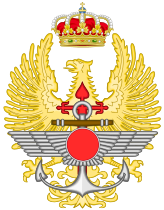

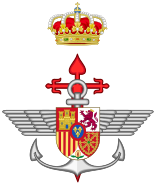




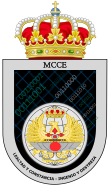


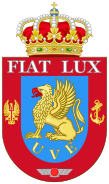








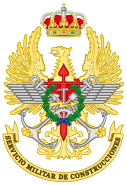












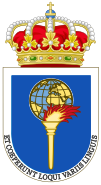










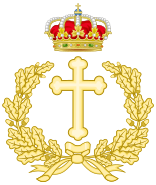







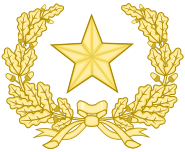







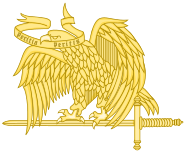
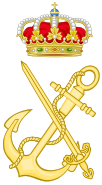




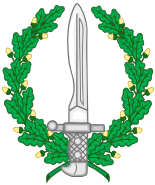
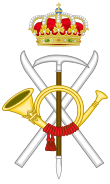

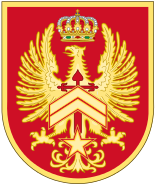




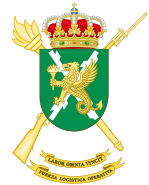
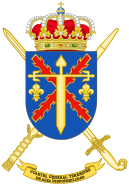
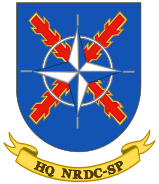


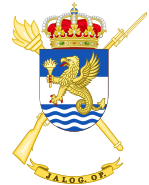
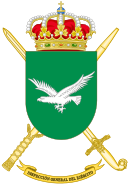

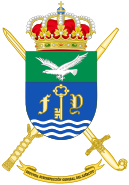




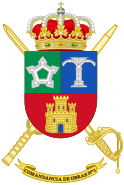





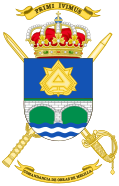
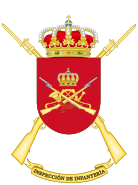

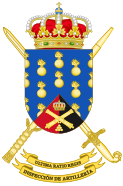


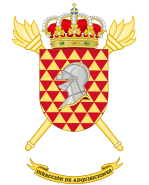


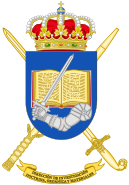
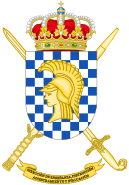




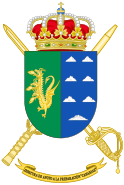
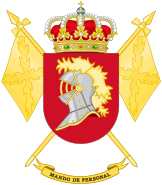





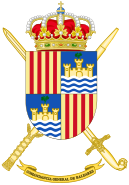

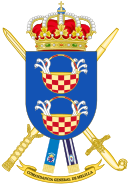






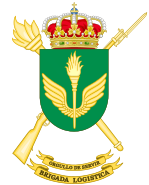









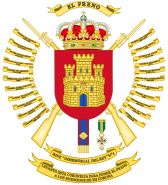













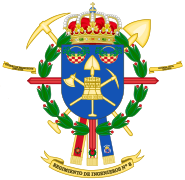








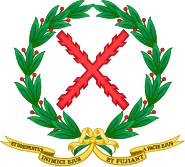

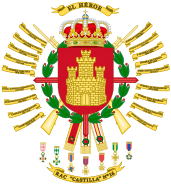

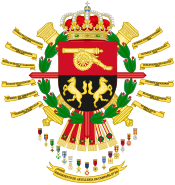








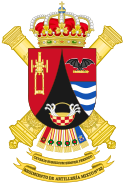


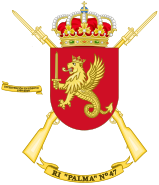






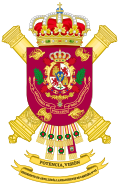














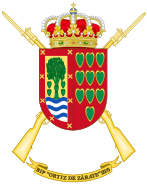
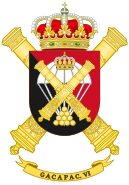













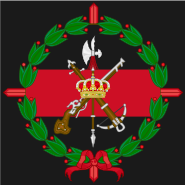


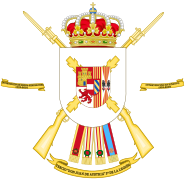


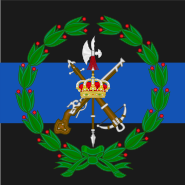





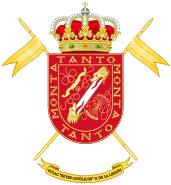










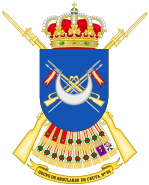







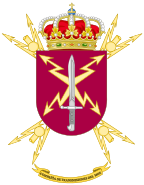

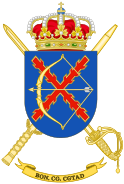

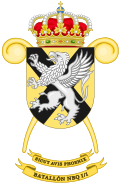



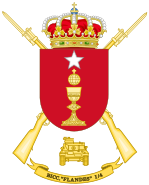







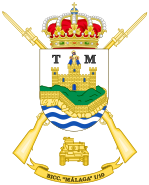



















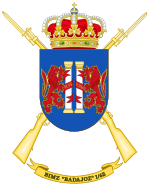



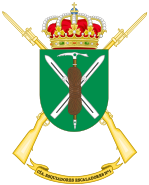







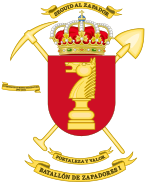





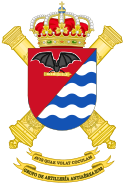
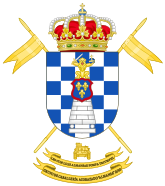







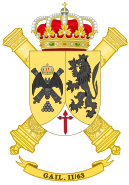



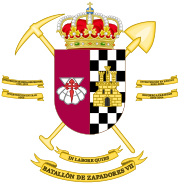








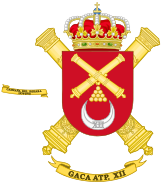











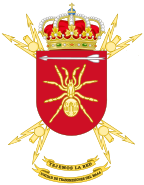
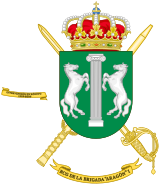

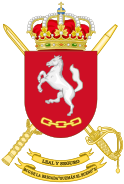


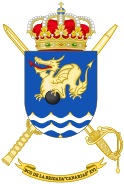














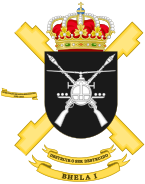


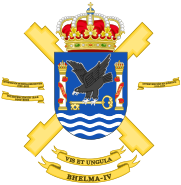






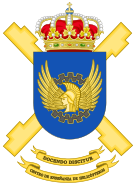



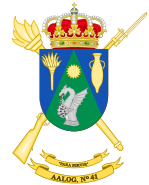




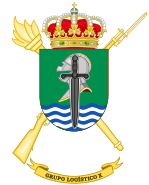






















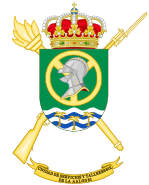



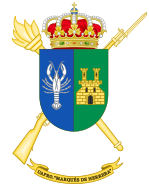













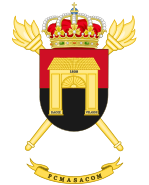


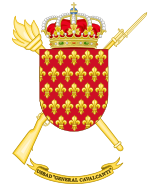












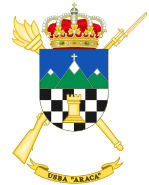






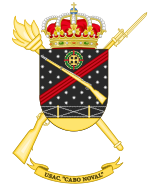















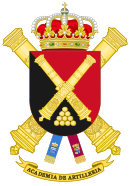
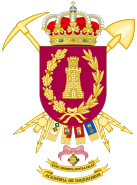


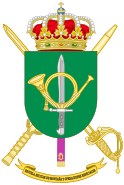






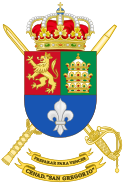
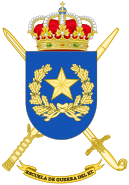







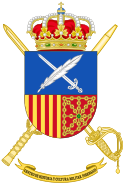
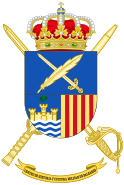







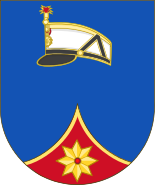

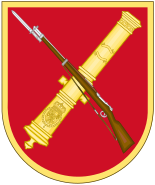

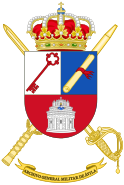


























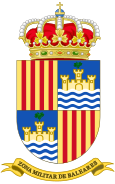



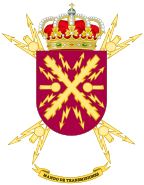
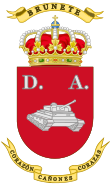



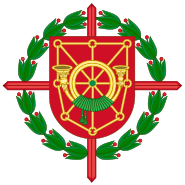
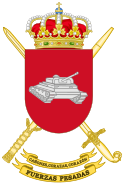

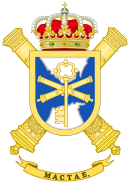




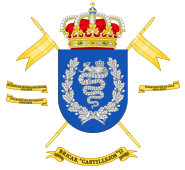
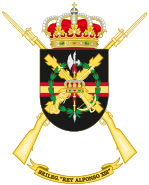



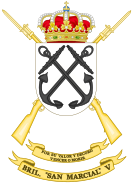













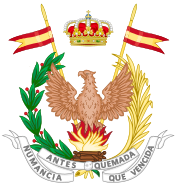




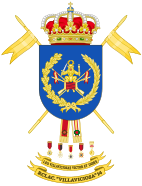


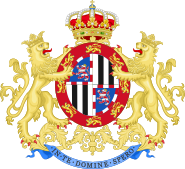



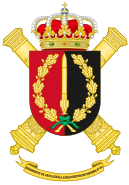
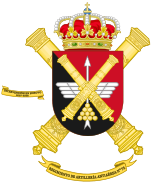



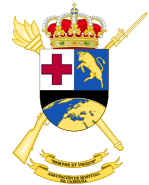
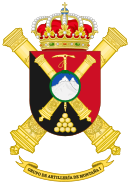







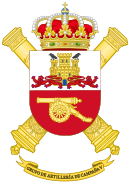












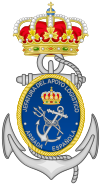























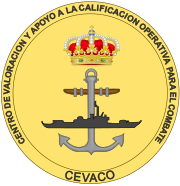














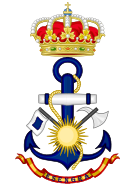


























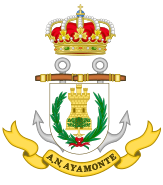

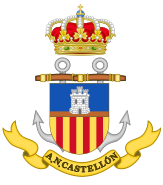

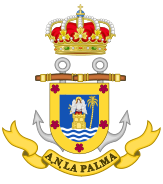



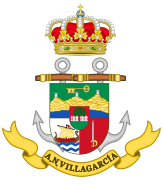







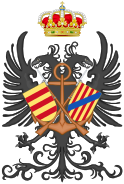


![Coat of Arms of the Spanish Marine Corps Northern Regiment.svg (472 KB) Coat of Arms of Northern Regiment [Tercio] (TERNOR) Naval Protection Force](https://upload.wikimedia.org/wikipedia/commons/thumb/0/0f/Coat_of_Arms_of_the_Spanish_Marine_Corps_Northern_Regiment.svg/121px-Coat_of_Arms_of_the_Spanish_Marine_Corps_Northern_Regiment.svg.png)
![Coat of Arms of the Spanish Marine Corps Southern Regiment.svg (1.34 MB) Coat of Arms of Southern Regiment [Tercio] (TERSUR) Naval Protection Force](https://upload.wikimedia.org/wikipedia/commons/thumb/e/ea/Coat_of_Arms_of_the_Spanish_Marine_Corps_Southern_Regiment.svg/130px-Coat_of_Arms_of_the_Spanish_Marine_Corps_Southern_Regiment.svg.png)
![Coat of Arms of the Spanish Marine Corps Eastern Regiment.svg (471 KB) Coat of Arms of Eastern Regiment [Tercio] (TERLEV) Naval Protection Force](https://upload.wikimedia.org/wikipedia/commons/thumb/b/bf/Coat_of_Arms_of_the_Spanish_Marine_Corps_Eastern_Regiment.svg/121px-Coat_of_Arms_of_the_Spanish_Marine_Corps_Eastern_Regiment.svg.png)






















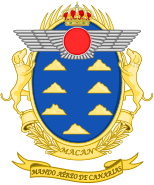
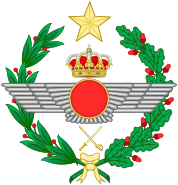
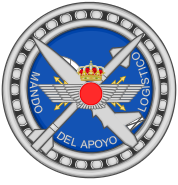
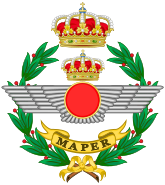


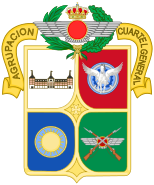



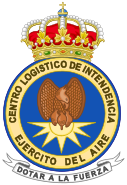

















![Coat of Arms of the Guardia Civil Operations Command.svg (2.22 MB) Operations Command (MOP) [Obsolete]](https://upload.wikimedia.org/wikipedia/commons/thumb/a/a2/Coat_of_Arms_of_the_Guardia_Civil_Operations_Command.svg/134px-Coat_of_Arms_of_the_Guardia_Civil_Operations_Command.svg.png)







